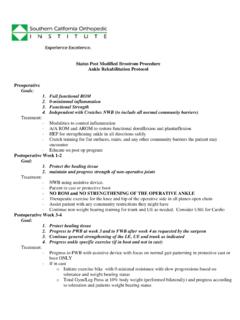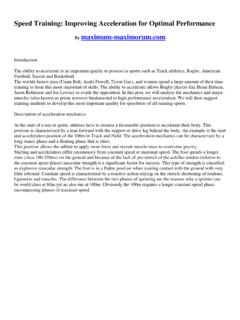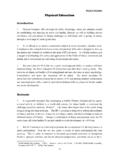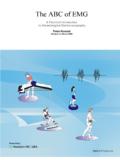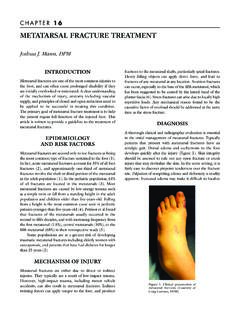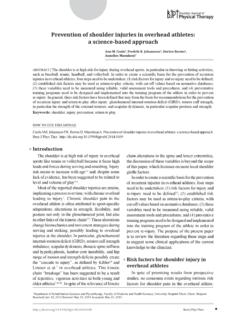Transcription of Laxity Testing of the Shoulder - Elbow Surgery Los …
1 INTRODUCTIONWith the increasing appreciation that all joints have a nor-mal Laxity pattern,7,31,67the challenge for the clinician is todistinguish normal Laxity from pathologic movements andinstability of the joint. Matsen et al58(p786)defined gleno-humeral Laxity as the ability of the humeral head to be pas-sively translated on the glenoid fossa and glenohumeralinstability as a clinical condition in which unwanted trans-lation of the head on the glenoid compromises the comfortand function of the Shoulder .
2 The Shoulder is the most mobile joint in the body, andthe Shoulder s range of normal Laxity values ,51,53,88,89,96 Determining Laxity of the glenohumeraljoint is challenging because of the complexity of the com-bined motions of the glenohumeral and scapulothoracicarticulations. Many clinicians believe that Shoulder laxityis difficult to assess on physical ,36,92,104 Although recent biomechanical and clinical studies havehelped to define normal Shoulder Laxity ,31,51,53,84,88,89,96clini-cians can still have difficulty distinguishing normal frompathologic Laxity , particularly in determining the direction ordirections in which the patient s Shoulder may be unstable.
3 Ifthe clinician confuses normal Laxity with instability andfails to identify the directions of instability, the method oftreatment chosen (operative or nonoperative) and, poten-tially, the final result may be affected. In 1980, Neer andFoster72described multidirectional instability (MDI) asinstability in two or more directions, and they suggestedthat the hallmark of inferior instability was a positive sul-cus sign. Their preliminary study described for the first timea heterogeneous group of patients who had ligamentous lax-ity, pain, and signs of instability.
4 They noted that for the sul-cus sign to be truly positive, it had to reproduce the patient ssymptoms of instability. However, the results of the work ofNeer and Foster are often misinterpreted, and subsequentreports have been inconsistent with regard to the criteria forinferior instability. One study has suggested that a positivesulcus sign should be based on the reproduction of symp-toms of inferior instability and not on an arbitrary study indicated that a sulcus sign determinedto be positive based on magnitude alone might cause MDI tobe overdiagnosed and might result in overtreatment of nor-mal Laxity , Laxity Testing of the Shoulder in an anterior-posterior direction has been recommended as a tool for deter-mining nonoperative or operative treatment.
5 The ability tosubluxate the Shoulder over the glenoid rim anteriorly orposteriorly, with the patient awake or under anesthesia, hasbeen interpreted by some authors to be a sign of ,4,12,17,26,68,70,83If the Shoulder can be subluxated over theglenoid rim anteriorly or posteriorly on Laxity Testing butdoes not reproduce symptoms of instability, the examinershould not interpret this as instability; the treatment cho-sen may be Testing of the ShoulderA ReviewMichael Bahk,* MD, Ekavit Keyurapan,* MD, Atsushi Tasaki,* MD, Eric L.
6 Sauers, PhD, ATC,and Edward G. McFarland,* MDFrom the *Division of sports Medicine and Shoulder Surgery , Department of OrthopaedicSurgery, Johns Hopkins University, Baltimore, Maryland, and the Department of sports HealthCare, Arizona School of Health Sciences, A. T. Still University, Phoenix, Arizona Laxity Testing is an important part of the examination of any joint. In the Shoulder , it presents unique challenges because of thecomplexity of the interactions of the glenohumeral and scapulothoracic joints. Many practitioners believe that Laxity Testing of theshoulder is difficult, and they are unclear about its role in evaluation of patients.
7 The objectives of the various Laxity and instabil-ity tests differ, but the clinical signs of such tests can provide helpful information about joint stability. This article summarizes theprinciples of Shoulder Laxity Testing , reviews techniques for measuring Shoulder Laxity , and evaluates the clinical usefulness of theshoulder Laxity tests. Shoulder Laxity evaluation can be a valuable element of the Shoulder examination in patients with shoulderpain and : Laxity Testing ; Shoulder ; review; physical examination131 Address correspondence to Edward G.
8 McFarland, MD, c/o Elaine , BJ, ELS, Medical Editor, Department of Orthopaedic Surgery , JohnsHopkins Bayview Medical Center, 4940 Eastern Ave., #A672, Baltimore,MD 21224-2780 (e-mail: potential conflict of interest American Journal of sports Medicine, Vol. 35, No. 1 DOI: 2007 American Orthopaedic Society for sports MedicineClinical sports Medicine Update132 Bahk et alThe American Journal of sports MedicineThe distinction between Laxity and instability is alsoimportant in overhead athletes, that is, those who reach orthrow overhead.)
9 The clinician must use a history of pain andphysical examination findings of a loose Shoulder to deter-mine whether the Shoulder pain is caused by covert shoul-der instability. Rowe and Zarins85were the first to suggestthat a dead arm resulted from occult instability. Jobeet al43popularized this concept of occult instability as asource of pain in the overhead athlete. They noted that over-head athletes had substantial Shoulder joint Laxity , particu-larly in the anterior direction, which has been speculated tobe the result of attenuation of the anteroinferior capsule sec-ondary to repetitive forceful abduction, external rotation,and horizontal abduction.
10 They associated this occult ante-rior instability with changes seen at the time of arthroscopy,including superior labral anterior posterior (SLAP) lesionsand partial rotator cuff tears. Although such patients infre-quently report that their shoulders subluxate or dislocate,they often complain that their Shoulder feels loose. 11 Thislooseness has been assumed to represent some form ofoccult Laxity , which Jobe et al43have suggested is anteriorinstability and others11,71have suggested is a form of supe-rior instability or superior pseudolaxity.
